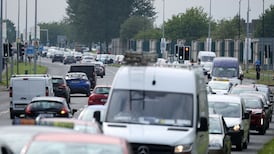An Aer Lingus pilot taking legal action over defamatory emails about him sent by the Irish Aviation Authority told the High Court there was "a large bullseye on my back" after he came into conflict with the IAA about its approach to validating licences for pilots using two-seat microlight aircraft.
Padraig Higgins of Enfield, Co Meath, was giving evidence in a hearing before a judge and jury to determine what damages he should receive for the defamation, for which the IAA has already apologised.
The case arose after Mr Higgins was involved in an incident in April 2013 when his single-engine microlight aircraft, which he uses in his spare time, had to make an emergency landing on rough ground near Swansea in Wales. It landed safely but the nose-wheel and propeller were damaged when it hit a rock. He had ensured before leaving that all his papers and licence allowing him to fly in UK airspace were in order.
In June 2013 the first of three defamatory emails was sent by John Steel, IAA manager of general aviation standards, to three IAA colleagues and to the UK's Civil Aviation Authority, which had found Mr Higgins had been properly licensed and had no case to answer. The last IAA email spoke of there being still "a couple of issues" and Mr Higgins and his fellow pilot "will not be getting away 'scot-free' ".
In evidence on Thursday, Mr Higgins, a former vice-chairman of the Irish Microlight Association, said that in that role he came into conflict with the IAA over efforts by the association to achieve better safety and training standards for its members. It culminated in a picket outside IAA headquarters by association members, which got TV coverage at a time when international auditors were in the building, he said. This resulted in a "bit of traction" for the association and led to the granting of 40 Irish licences and the recognition of 38 UK licences here.
Problems arose
However, problems arose in 2011 over the issue of which instructors should be used as part of the two-year validation process to allow pilots to continue to hold licences. The microlight association proposed two highly qualified UK instructors, but the IAA wanted its own. Mr Higgins said the first time those IAA instructors got into an aircraft, there was an accident that left one man with a brain injury and the other using a walking frame.
When the IAA insisted it would continue to appoint the instructors, he said the association threatened an injunction, and he said he would hold them responsible for any further accidents and send the files on any such accidents to the next of kin. As a result of that, “I knew I had a large bullseye on my back”.
Around the time the Civil Aviation Authority closed its inquiry into the Swansea case, he said he was hearing rumours and told to “watch my back, I was in trouble with the IAA”.
He sought data held on him by the IAA and was given just one “pretty innocuous” email, but the UK authority provided him with 100 pages, including the defamatory emails. He said he could see from this the IAA was trying to take his career and livelihood off him. He was devastated he had been accused of what was a criminal offence and of putting his own life and a passenger’s life in danger when there was no basis to the allegation.
Earlier Mr Justice Bernard Barton told the jury an article by journalist John Mulligan on Independent.ie about the first day of the case stated the IAA had agreed to pay "substantial" damages to Mr Higgins. The judge said that was "outrageously wrong". He said what was said in the apology was the IAA had agreed to "pay [him] damages".
The jury was to determine those damages, he said. The case continues.









